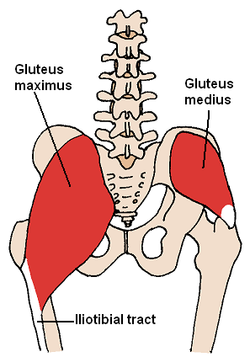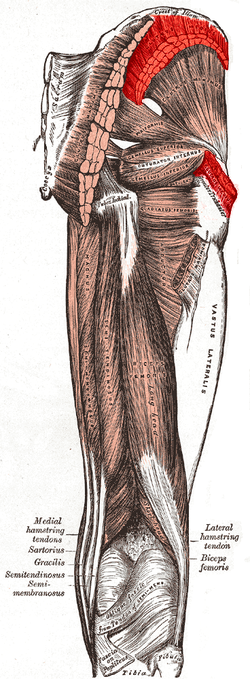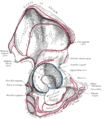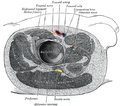- Gluteus medius muscle
-
Gluteus medius The gluteus medius and nearby muscles Muscles of the gluteal and posterior femoral regions with origin and insertion of gluteus medius muscle labeled Latin musculus gluteus medius Gray's subject #128 474 Origin Gluteal surface of ilium, under gluteus maximus Insertion Greater trochanter of the femur Artery superior gluteal artery Nerve superior gluteal nerve (L4, L5, S1 nerve roots) Actions abduction of the hip; preventing adduction of the hip. Medial rotation of thigh. Antagonist lateral rotator group The gluteus medius (or glutæus medius), one of the three gluteal muscles, is a broad, thick, radiating muscle, situated on the outer surface of the pelvis.
Its posterior third is covered by the gluteus maximus, its anterior two-thirds by the gluteal aponeurosis, which separates it from the superficial fascia and integument.
Contents
Relations
A bursa separates the tendon of the muscle from the surface of the trochanter over which it glides.
Origin and insertion
The gluteus medius muscle starts, or "originates," on the outer surface of the ilium between the iliac crest and the posterior gluteal line above, and the anterior gluteal line below; the gluteus medius also originates from the gluteal aponeurosis that covers its outer surface.
The fibers of the muscle converge into a strong flattened tendon that inserts on the lateral surface of the greater trochanter. More specifically, the muscle's tendon inserts into an oblique ridge that runs downward and forward on the lateral surface of the greater trochanter.
Action
With the leg in neutral (straightened), the gluteus medius and gluteus minimus function together to pull the thigh away from midline, or "abduct" the thigh. During gait, these two muscles function principally in supporting the body on one leg, in conjunction with the tensor fascia lata, to prevent the pelvis from dropping to the opposite side.
Additionally, with the hip flexed the gluteus medius and minimus externally rotate the thigh. With the hip extended, the gluteus medius and gluteus minimus internally rotate the thigh.[1]
Dysfunction of the gluteus medius or the superior gluteal nerve can potentially be indicated by a positive Trendelenburg's sign.
Variations
The posterior border may be more or less closely united to the piriformis, or some of the fibers end on its tendon.
The posterior fibres of gluteus medius contract to produce hip extension, lateral rotation and abduction. During gait, the posterior fibres help to decelerate internal rotation of the femur at the end of swing phase.
Additional images
See also
References
- ^ Pratt, N. Clinical Musculoskeletal Anatomy. CBLS: Marietta, OH 2004.
External links
This article was originally based on an entry from a public domain edition of Gray's Anatomy. As such, some of the information contained within it may be outdated.
List of muscles of lower limbs (TA A04.7, GA 4.465) ILIAC Region
/ ILIOPSOASBUTTOCKS THIGH /
compartmentsLEG/
Crus/
compartmentssuperficial · triceps surae (gastrocnemius, soleus, accessory soleus, Achilles tendon) · plantaris
deep · tarsal tunnel (flexor hallucis longus, flexor digitorum longus, tibialis posterior) · popliteusFOOT DorsalPlantar1st layer (abductor hallucis, flexor digitorum brevis, abductor digiti minimi) · 2nd layer (quadratus plantae, lumbrical muscle) · 3rd layer (flexor hallucis brevis, adductor hallucis, flexor digiti minimi brevis) · 4th layer (dorsal interossei, plantar interossei)Categories:- Hip abductors
- Hip lateral rotators
- Hip medial rotators
- Muscles of the gluteus
Wikimedia Foundation. 2010.







